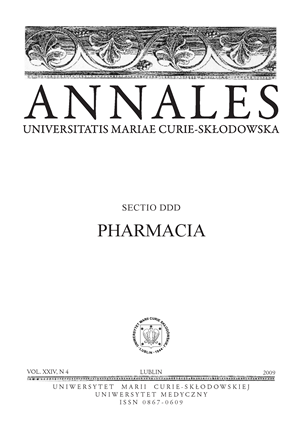Chromatograficzna analiza kwasów fenolowych w uprawianych gatunkach z rodzaju Aloë
Abstrakt
Różne gatunki aloesów są od wieków znanymi i cenionymi roślinami leczniczymi. Rośliny te wykazują m.in. działanie immunostymulujące, przeczyszczające, przeciwbakteryjne, przeciwgrzybicze, żółciopędne, ułatwiające gojenie ran. W pracy metodami chromatograficznymi (TLC, HPLC) analizowano obecność i zawartość kwasów fenolowych w kilku gatunkach aloesów ze szczególnym uwzględnieniem Aloë arborescens Mill. W rezultacie w jego liściach stwierdzono występowanie 13 fenolokwasów: ferulowego, p-kumarowego, homoprotokatechowego, β-fenylośminlekowego, protokatechowego, kawowego, p-hydroksyfenylooctowego, p-hydroksybenzoesowego, wanilinowego, syryngowego, o-hydroksyfenylooctowego, trans-cynamonowego oraz estru metylowego kwasu p-kumarowego oraz określono zawartość głównych związków z tej grupy, która kształtowała się w zakresie od 0,01 mg % (dla wolnego kwasu protokatechowego) do 1,46 mg % (kwasu cis -p-kumarowego, uwolnionego w wyniku hydrolizy zasadowej) w świeżym surowcu oraz odpowiednio 0,26 mg %–41,81 mg % w surowcu wysuszonym. Chromatograficznie porównano również obecność kwasów fenolowych w liściach sześciu innych gatunków z rodzaju Aloë.
Bibliografia
1. Adamski R., Kodym A.: Badanie zawartości substancji chemicznych zawartych w preparacie Biostymina oraz w liściach trzyletnich roślin Aloe arborescens Mill. uprawianych w cieplarniach. cz. IV. Analiza białka, aminokwasów oraz substancji niebiałkowych zawierających azot w preparacie Biostmina. Herba Pol., 22 (3-4), 262, 1976.
2. Adamski R.: Badanie porównawcze składu chemicznego preparatu „Biostymina” ze składem soków świeżego i wysuszonego, otrzymanych z liści Aloe arborescens Mill. za pomocą chromatografii cienkowarstwowej. Farm.Pol., 27 (11), 909, 1971.
3. Bassetti A., Sala S.: The great book of Aloë. Zuccari, Trento 2005.
4. Chun-Hui L., Chang-Hai W., Zhi-Liang X., Yi W.: Isolation, chemical characterization and antioxidant activities of two polysaccharides from the gel and the skin of Aloë barbadensis Miller irrigated with sea water. Process Biochemistry, 42, 961, 2007.
5. Dagne E., Alemu M.: Constituents of the leaves four Aloë species from Ethiopia. Bull., Chem. Soc. Ethiop., 5 (2), 87, 1991.
6. Eun A. Y., Sung D. K., Whi M. L. et al.: Evaluation of antioxidant, antinociceptive, and anti-inflammatory activities of ethanol extracts from Aloë saponaria. Phytother. Res., 22 (10), 1389, 2008.
7. Hidehiko B., Kaoru K., Kan S. et al.: Studies on the components of Aloe arborescens from Japan – monthly variation and differences due to part and position of the leaf. Biochemical Systematics and Ecology, 32, 783, 2004.
8. Ibrahim R. K., Tower s G. H.: Identification by chromatography of plant phenolic acids, Aren. Biochem. Biophys. 87, 125, 1990.
9. Keyhanian S., Stahl-Biskup E.: Phenolic constituents in dried flowers of aloe vera (Aloe barbadensis) and their in vitro antioxidative capacity. Planta Med., 73 (6), 599, 2007.
10. Kodym A.: Substancje biologicznie aktywne liści aloesu drzewiastego (Aloe arborescens Mill.) uprawianego w cieplarniach Zakładów Zielarskich „Herbapol” w Klęce. Farm. Pol., 54 (19), 887, 1998.
11. Loots du T., van der Westhuizen F.H., Botes L.: Aloë ferox leaf gel phytochemical content, antioxidant capacity, and possible health benefits. J Agric Food Chem., 55 (17), 6891, 2007.
12. Mrozowski T.: Aloes – właściwości lecznicze i zastosowanie. Wiad. Zielar., 44 (12), 5, 2002.
13. Niedwork J.: Zastosowanie lecznicze aloesu drzewiastego, 43 (11), 3, 2001.
14. Nowak R., Starek K.: Składniki chemiczne roślin z rodzaju Aloë L. i ich aktywność farmakologiczna. I. Pochodne antracenu. Herb. Pol., 49 (1-2), 115, 2003.
15. Nowak R.: Comparative study of phenol acids in pseudofruits of some species of roses. Acta Polon Pharm., Drug Res., 63 (4), 281, 2006.
16. Okamura N., Masami A., Noriko H., Akira Y.: High-performance liquid chromatographic determination of phenolic compounds in Aloë species. Journal of Chromatogr. A, 746, 225-231, 1996.
17. Olennikov D. N., Ibragimov T. A., Chelombitko V. A. et al.: Chemical composition of Aloë arborescens and its change by biostimulation. Chem. Nat. Compd. 45 (4), 478, 2009.
18. Olennikov D. N., Rokhin A. V., Zilfikarov I. N.: Method for determining content of phenolic compounds in Aloë arborescens. Chem. Nat. Compd. 44 (6), 715, 2008.
19. Ożarowski A.: Aloesy jako rośliny lecznicze. Wiad. Ziel., 3, 1, 1996.
20. Rebecca W., Kayser O., Hagels H. et al.: The phytochemical profile and identification of main phenolic compounds from the leaf exudate of Aloë secundiflora by high-performance liquid chromatography-mass spectroscopy, Phytochemical Analysis, 14 (2), 83, 2003.
21. Rosca-Casian O., Parvu M., Vlase L., Tamas M.: Antifungal activity of Aloe vera leaves. Fitoterapia, 78, 219, 2007.
22. Smolarz H.D., Waksmundzka-Hajnos M.: Two-Dimensional TLC of phenolic acids on cellulose, J. Chromatogr., 6, 278, 1993.
23. Umbreit M.H.: Wskazania do stosowania produktów z aloesu jako food sopplements, Nowiny Lekarskie, 64 (5), 6, 1995.
24. Young Lee K., Weintraub S. T., Pal Yu B.: Isolation and identification of a phenolic antioxidant from Aloë barbadensis. Free Rad. Biology & Medicine, 28 (2), 261, 2000.
25. Zh Y.: Effect of Aloë vera polysaccharides on immunity and antioxidant activities in oral ulcer animal models. Carbohyd. Polym., 10, 2008.
Pobrania
Opublikowane
Numer
Dział
Licencja
Prawa autorskie (c) 2009 Autorzy

Praca jest udostępniana na licencji Creative Commons Attribution-NonCommercial-NoDerivatives 3.0 Unported License.


